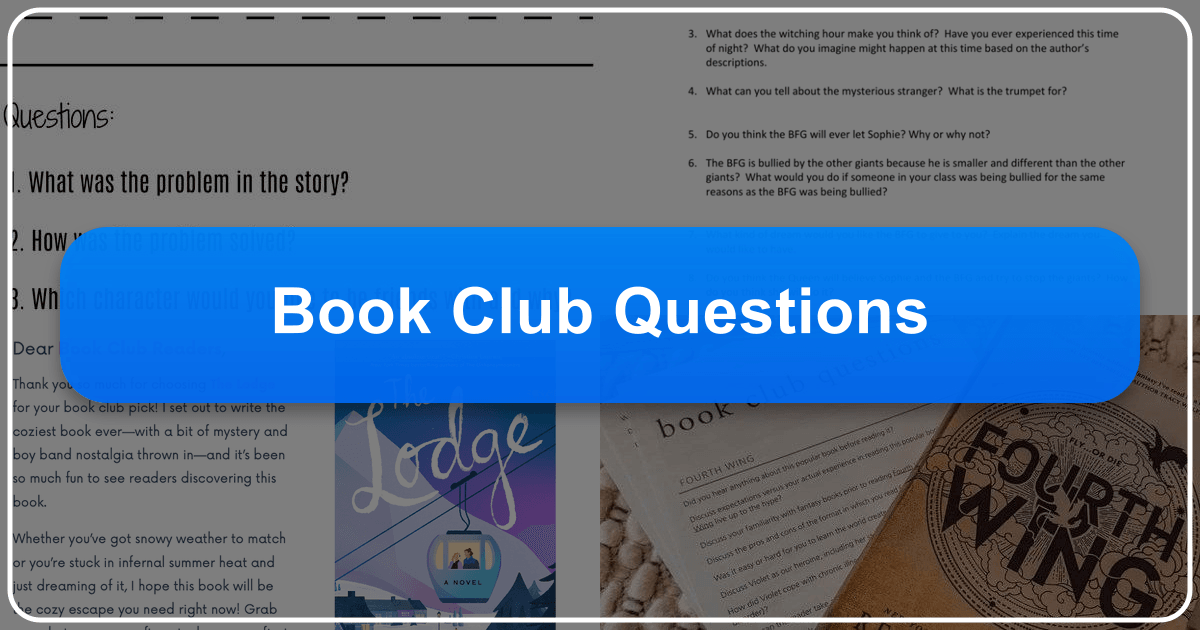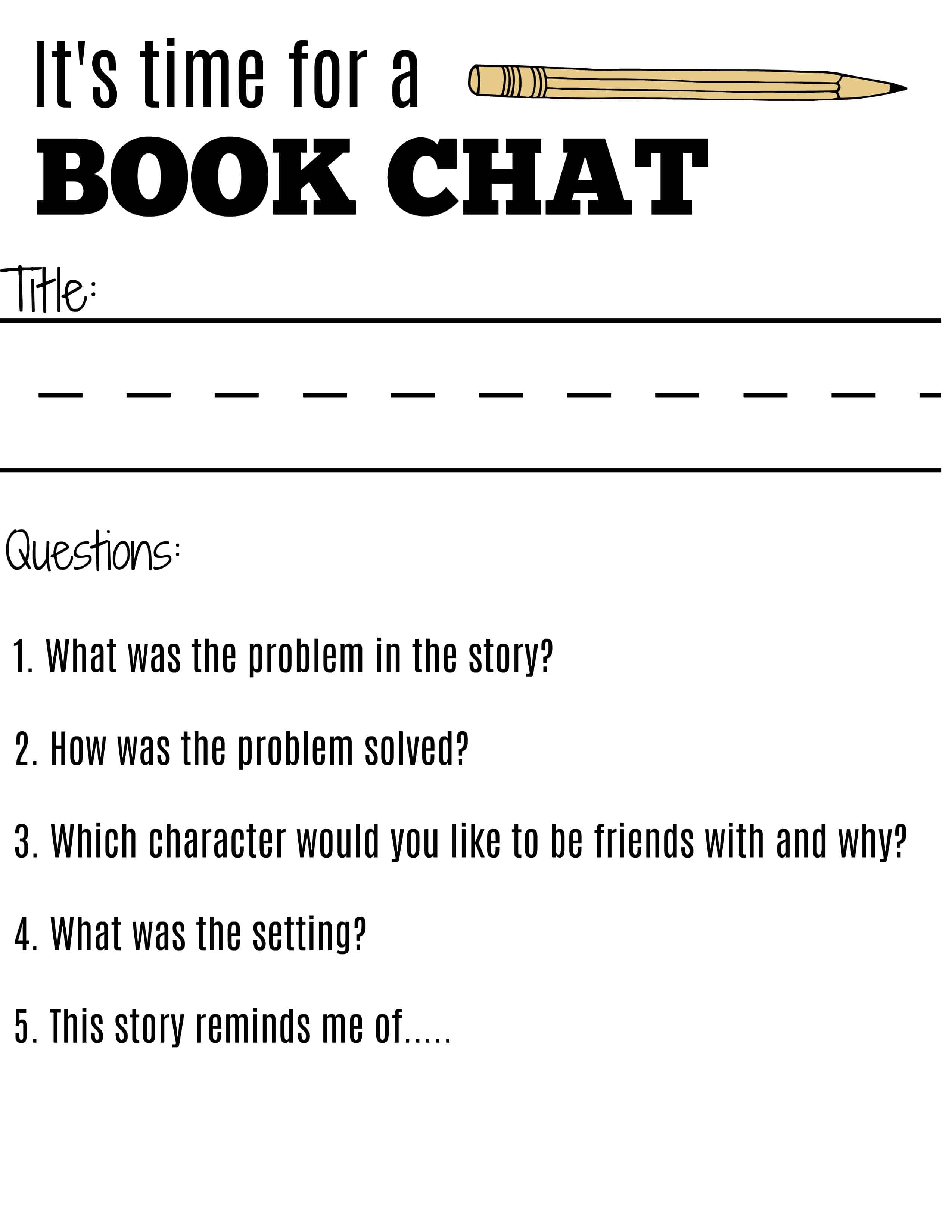Book Club Questions: A Comprehensive Guide to Stimulating Discussions

Book clubs offer a wonderful opportunity to connect with others, share perspectives, and delve deeper into the worlds created within the pages of a book. However, sometimes finding the right questions to spark engaging conversations can be challenging. This comprehensive guide provides a wealth of book club discussion questions categorized for ease of use, ensuring your next book club meeting is lively, insightful, and memorable. We’ll explore questions that address various aspects of literature, from plot and character development to themes, symbolism, and the author’s craft. Furthermore, we will examine how these questions can be adapted to fit different genres and reading levels.

Exploring the Narrative: Plot and Structure
The plot of a book forms its backbone, driving the narrative forward and shaping the reader’s experience. Engaging questions about the plot can uncover diverse interpretations and highlight the author’s skill in constructing a compelling story.
Unpacking the Plot’s Progression
- What were your initial expectations for the book, and did it meet them? This question helps gauge initial impressions and whether the book delivered on its promise.
- Were there moments in the plot that were unpredictable? Were there any twists or surprises you didn’t see coming? Or were there plot twists that were not surprising? This probes the element of surprise and suspense, encouraging discussion about the author’s techniques in maintaining reader interest.
- How did the story’s pacing affect your reading experience? Did the story ever feel too fast or too slow? This explores the rhythm and tempo of the narrative, highlighting how pacing influences emotional engagement.
- What parts of the plot felt surprising, if any? This allows members to pinpoint specific moments that stood out and analyze their impact.
- How did the book’s title influence your perception of the story before reading? After finishing the book, do you think the title is fitting, or would you suggest a different one? This insightful question examines the relationship between title and content, exploring the author’s choices and the reader’s interpretations.
- If you could change one event in the book, which would it be and why? This imaginative question encourages creative thinking and reveals individual perspectives on the narrative’s causality.
Delving into Character: Development and Relationships
Characters are the heart of a story, driving the action and evoking emotional responses from the reader. Understanding character development and the relationships between characters is crucial for a complete appreciation of the narrative.
Analyzing Character Arcs and Interactions
- How would you describe the main characters? For example: were they relatable, realistic, or well-developed? This question encourages a critical examination of character portrayal, addressing realism and relatability.
- Which character did you relate to the most, and why? This personal question allows members to share their emotional connections with characters, revealing insights into their own values and experiences.
- Were there any characters you disliked? What made them unlikable? This explores the author’s skill in creating complex and even antagonistic characters, and how these characters contribute to the narrative’s impact.
- How do the characters change and develop throughout the book? Did any character’s development surprise you? This focuses on character arcs, exploring growth, transformation, and unexpected turns.
- Did any character make a decision that you strongly agreed or disagreed with? How would you have handled the situation differently? This invites a discussion of moral choices, prompting members to consider their own perspectives and values.
- How do you think the book would have been different if told from another character’s perspective? This question explores narrative voice and perspective, highlighting the impact of point of view on the reader’s experience.
- What do you think happens to the characters after the story ends? This encourages speculation and imaginative extrapolation beyond the book’s confines.
- Did you relate to a particular character or the circumstances they were in? Were the characters believable? For example, does the narrator sound age-appropriate? These questions explore the reader’s emotional connection and the author’s success in creating believable and relatable characters.
Setting the Scene: Atmosphere and Impact
The setting of a story is more than just a backdrop; it can shape the characters’ actions, influence the plot, and create a specific atmosphere. Examining the setting allows for a deeper understanding of the story’s context and impact.
Exploring the Role of Setting
- Did the setting play a significant role in the story? How might the plot change if it were set in a different time or place? This explores the setting’s influence on the narrative, prompting consideration of alternative contexts.
- If you had to move the story to a different setting, what would you choose? This imaginative question encourages creative thinking and reveals members’ preferences and perceptions.
- Would you like to visit the setting of the book? If familiar with the setting, did it ring true? This question connects the fictional world to the reader’s own experiences and understanding of place.
- How did the author’s writing style contribute to the story’s tone and atmosphere? This connects the author’s craft to the overall effect of the narrative, highlighting style and tone.
Unveiling Deeper Meanings: Themes and Symbolism
Beyond the surface narrative, many books explore complex themes and utilize symbolism to add layers of meaning. Exploring these aspects enriches the reading experience and sparks insightful discussions.
Analyzing Themes and Symbolic Elements
- What were the themes in this book? What themes or messages did you identify in the book? This encourages members to identify the underlying messages and ideas explored in the story.
- Were there any symbols or motifs in the book? How did they enhance the story? This probes the use of symbolism and recurring motifs, examining their contribution to the narrative’s meaning.
- Did the book’s portrayal of relationships (friendship, family, romantic, etc.) feel authentic? Which relationship dynamics stood out to you, and why? This focuses on character relationships, examining their realism and significance within the story.
- Did the book address any real-world issues or themes? How did the author handle real-world topics, and did they affect your views on those issues? This explores the book’s connection to real-world concerns and its potential to impact readers’ understanding of those issues.
- Were there any images that felt like they had a hidden meaning? This allows for interpretation and discussion of symbolic imagery and its impact on the overall message.
The Author’s Craft: Narrative and Style
The author’s choices in narrative voice, writing style, and structure significantly impact the reader’s experience. Analyzing these aspects provides valuable insights into the author’s craft and the effectiveness of their storytelling.
Examining the Author’s Techniques
- How would you describe the narrator’s perspective? Was the narrator reliable, or did you find them biased? Did you question the truth? This explores narrative voice and perspective, examining the narrator’s reliability and the potential for bias.
- How did the author use humor, suspense, or other literary devices to enhance the story? This analyzes the author’s use of literary techniques and their contribution to the overall effect of the story.
- Were there any parts of the book you found difficult to understand or follow? Why? This provides an opportunity to discuss potential ambiguities or complexities in the narrative.
- If you could ask the author one question about the book, what would it be? This imaginative question reveals individual curiosities and areas of interest.
- Do you have any unresolved questions or loose ends at the end of the book? Do you think the author did this purposely? This prompts discussion about the ending and the author’s intentions regarding ambiguity or open conclusions.
Reflecting on the Reading Experience: General Impressions
Finally, reflecting on the overall reading experience allows for a comprehensive understanding of the book’s impact and lasting impressions.
Sharing Overall Thoughts and Opinions
- What were your thoughts on the book’s ending? Was it satisfying, or did it leave you wanting more? This explores the impact of the ending and its effectiveness in resolving the narrative.
- What aspects of the book did you find most thought-provoking or insightful? This identifies the most significant takeaways and reveals individual perspectives.
- Did the book remind you of any other books you’ve read? If so, in what ways? This explores intertextuality and the book’s relationship to other works of literature.
- What did you learn from the book, if anything? Did this book change your perspective on any topic? This addresses the book’s educational value and its potential to influence readers’ perspectives.
- Would you recommend this book to others? Why or why not? And if so, who should read this book? This final question encourages evaluation and recommendation, fostering further engagement with the book and its potential audience.
- If this book were adapted into a film, who would you cast as the main character? Would you want to see a sequel to this book and if so, what would it be about? These questions encourage creative thinking and further engagement with the story and its characters.
By utilizing these diverse categories of book club questions, your discussions will be enriched, leading to a more profound understanding and appreciation of the chosen literature. Remember, the most important aspect of a book club is the shared enjoyment and exploration of literature together. Use these questions as a springboard for your conversations, and let the discussions flow organically.